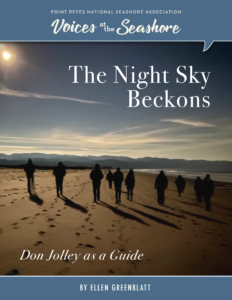(Republished from Voices of the Seashore)
by Ellen Greenblatt

Don Jolley is concerned that we might be missing half of what life has to offer. With our eyes down to the ground or, more often, on our phones, we don’t experience much of our world, especially the rich natural display above us.
In his role as one of the stalwart leaders of Point Reyes National Seashore Association’s Full Moon Hikes, Don encourages PRNSA members to look up, to see what’s in the sky, and notice where we are in time and space.
He clearly believes in Wallace Stegner‘s comment: “If we don’t know where we are, we don’t know who we are.” Don issues irresistible invitations to interact, punctuating the observations and questions of others with his own rich explanations and good humor.
Don, a born teacher, has become a hero to the adventurers who participate in PRNSA’s Full Moon Hikes, offered most months in different locations throughout Point Reyes National Seashore. He asserts that the most important question he can ask as a teacher is, “What do you think, not what do you know?”
He knows what he is talking about after 30 years of teaching science at Bolinas Middle School, where he told his adolescent students what he now tells adult learners: “I can’t teach you anything – you have all the information. All I can do is teach you how to ask questions to access what you already know.”
Follow Your Curiosity
After all, as he explains, the sky is available to you every single night. You don’t need credentials – all you have to do is look up and follow your curiosity to learn culture, history, and art as you are beguiled by the beauty of the night sky.
How does Don, who started as a fine arts major, know so much? He is a self-confessed reader and explorer, an autodidact, a paragon of following his curiosity and then learning on his own. For example, he is wonderfully knowledgeable about Greek mythology, and he deftly uses his knowledge to point out constellations viewable even on full-moon nights. But he learned mythology as a result of looking at the stars, not as an academic exercise.
Don has hiked under stars for 30 years, long before moon hikes, practicing naked-eye astronomy, mapping stars, making the celestial world visible by constructing his own planispheric astrolabe. The astrolabe, Don explained, was an early scientific instrument used for reckoning time and for observational purposes. It allowed astronomers long ago to calculate the position of the sun and prominent stars with respect to both the horizon and the meridian.

During his first foray at leading a Full Moon Hike, Don led his enthralled listeners, who have come to be known as “moon walkers,” past their basic knowledge of the effect of the moon on tides. Using an apple stuck in a pencil as a prop, with the backdrop of Drakes Estero, Don explained the additional effect of the earth’s distance from the sun on super low and super high tides.
Don looked up, he wanted to know, and he taught himself. Now he inspires others to discover their own questions and to seek their answers. He believes that everyone can be a community scientist.
Sparking a Dark Sky Movement
So how did Don move from leading Full Moon Hikes for PRNSA to leading groups of people to look at stars on moonless, almost always cold, evenings near the White Barn in the Giacomini wetlands?
Don asserts that he was just in the right place at the right time when the movement to turn Point Reyes and the area around it into an official “International Dark Sky Reserve” started to organize. The local movement needed an educator, and, as a widely-known and revered teacher, Don was a natural choice.
Unsurprisingly, he accepted. As a result, Don has become immersed in the Dark Sky movement in West Marin, and the people he draws to these moonless, star-watching nights are riveted by his stories.
Just as with the PRNSA Full Moon hikes, Don is passionate about connecting people with the sky because, as he knows, “that a disconnect with the sky is symbolic of the general disconnect with nature that lies at the heart of every environmental calamity we face today. The sky is accessible to everyone – if we’re unaware of what’s
in plain view overhead, then what hope is there of grasping the crucial elements beyond our line of sight or beyond our day-to-day experience?”
Don loves the tale of Thales of Miletus, a pre-Socratic philosopher from around 540 BCE. Thales, the story goes, was walking along looking up at the sky, so captivated by what he was seeing, that he tumbled into a well. Thales became the object of jokes.
The moral, Thales’ Greek commentators concluded, was that you had better keep your eyes on the ground.
But, says Don Jolley, the ancient Greeks who made fun of Thales for looking up got it all wrong: the sky, whether illuminated by a full moon or strewn with stars on a dark night, is always there to teach us. Don urges us to look up and learn, even as we are dazzled by the beauty of what we are seeing.
Ellen Greenblatt is a writer, a Winter Wildlife Docent, and a PRNSA volunteer and member who
is a regular on our Full Moon Member hikes.
Originally published by
POINT REYES NATIONAL SEASHORE ASSOCIATION | April 22, 2022